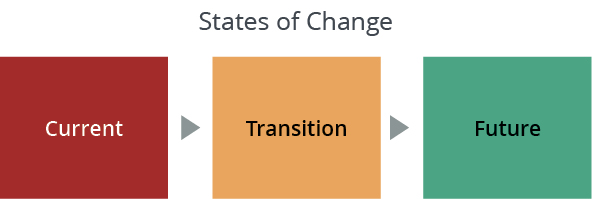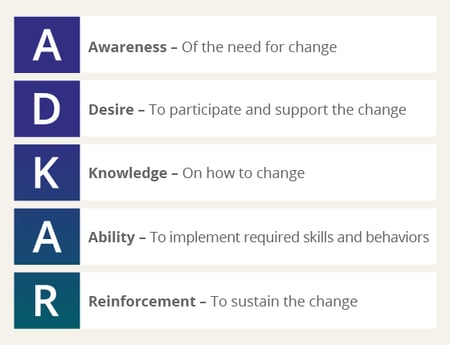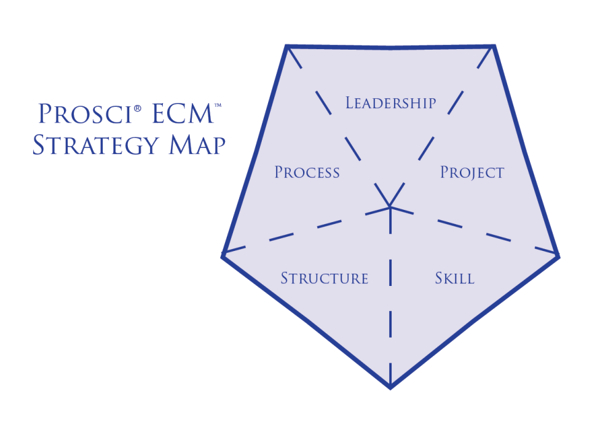Change Is a Process

6 Mins
Updated: March 17, 2024
Published: November 3, 2021

Change occurs as a process, not as an event. Organizational change does not happen instantaneously because there was an announcement, a kickoff meeting, or even a go-live date. Individuals do not change simply because they received an email or attended a training program. When we experience change, we move from what we had known and done, through a period of transition, to arrive at a desired new way of behaving and doing our job.
Treating change as a process is a central component of successful change and successful change management. This aligns with the fourth of the Five Tenets of Change Management: "Change management is an enabling framework for managing the people side of change." By breaking change down into distinct phases, you can better customize and tailor your approach to ensure that individuals successfully adopt the change to how they work.
Welcome! If you're just starting your change management journey,
Prosci is here to support you with free resources.
Get to know change management, the way it works, how to get started, and more.
Understanding Change as a Process
It is easy to see changes in nature occurring as a process. Whether it is a caterpillar turning into a butterfly or winter shifting into spring, we can easily appreciate the process of change. But when we begin changing our organization with projects and initiatives, we often forget the fact that change does not happen instantaneously.
The easiest, most basic approach to understanding change as a process is to break change down into distinct, understandable elements. The three states of change provide a powerful framework: the current state, the transition state, and the future state.

- The current state is how things are done today. It is the collection of processes, behaviors, tools, technologies, organizational structures and job roles that constitute how work is done. The current state defines who we are. It may not be working great, but it is familiar and comfortable because we know what to expect. The current state is where we have been successful and where we know how we will be measured and evaluated. Above all else, the current state is known.
- The transition state is messy and disorganized. It is unpredictable and constantly in flux. The transition state is often emotionally charged—with emotions ranging from fear and despair to anger and relief. During the transition state, productivity predictably declines. The transition state requires us to accept new perspectives and learn new ways of behaving, while still keeping up our day-to-day efforts. The transition state is challenging.
- The future state is where we are trying to get to. It is often not fully defined and can actually shift while we are trudging through the transition state. The future state is supposed to be better than the current state in terms of performance. The future state can often be worrisome. The future state may not match our personal and professional goals, and there is a chance that we may not be successful in the future state. Above all else, the future state is unknown.
The three states of change provide a way to articulate how change actually occurs. Whether the change is an ERP application, a new performance review process, a new piece of machinery on the production line, an optimized and managed set of business processes, or a new reporting structure, there is always a current state, future state and transition state.
Think about a project you are working on, which is impacting you. Using the following table, try to define each of the three states of change, and come up with an adjective to describe each state.
| Description | Adjectives Describing That State | |
| Current: | ||
| Transition: | ||
| Future: |
To take the understanding of change as a process one step further, think about who in the organization spends their time focused on the current state, transition state and future state. The table below considers three audiences and how they view the states of change.
| Current State | Transition State | Future State | |
| Executives and senior leaders | What I need to change, and why I am trying to implement change | A necessary evil to get me where I want to be | The goal that I have decided to move my organization toward |
| Project teams | What I'm starting with and must improve | The focus of my daily work, and what I'm charged with solving | Where we ultimately want to end up |
| Front-line employees, managers, and supervisors |
The day-to-day work I do to deliver value to the organization | A disorganized inconvenience to me doing my job | An unknown that may or may not be good for me |
Executives and senior leaders live in the future state. They are responsible for and compensated for deciding how the organization should function in six months, one year, three years, etc. Project teams live in the transition state. They investigate alternatives, decide on a path, and develop a solution to change the organization. Employees, managers and supervisors live in the current state. They cannot simply stop their work to implement a change. They are responsible for keeping the organization functioning while a change is being implemented.
The disconnect here can have significant ramifications when it comes to communicating about change. Senior leaders tend to focus on and speak about vision, almost detrimentally in some instances. Project teams tend to focus their communications on the details of their solution, the milestones, and the time frames for when change will happen. Employees want to know why the things they are doing now (the current state) need to be changed in the first place. Change practitioners play a key role in bridging the gaps between the three states of change.
Change Management as a Process
Once you think about change not as a singular event but as a process, you can start thinking about how to manage the process of change. Managing change as a process takes place on three levels: individual, organizational and enterprise.
Individual level of change
Each individual employee or manager who is impacted by a change must go through their own personal process of change. If the change impacts five people, each of those five must move from their current state, through their transition state, and to their own future state. If the project impacts 500 people, there are 500 current-transition-future processes that must occur. If the initiative impacts 5,000 people, there are 5,000 individuals moving from a current state to a future state. This is the essence of change management: supporting individuals through the required personal transitions necessary for a project or initiative to improve the performance of the organization.
The Prosci ADKAR Model provides a more detailed description of how an individual successfully moves from their current state to their future state. The ADKAR Model describes the five building blocks of successful change:

Whether it is a change at home, in the community, or at work, individuals are successful at change when they have Awareness, Desire, Knowledge, Ability and Reinforcement. This results-oriented description of the individual change process gives change management practitioners a new focus. For example, instead of seeing their job as "creating a communications plan," an effective practitioner with a focus on the individual change process sees their job as "creating Awareness" and so forth.
Consider two final observations about change as a process at the individual level. First, people will start the change process at different points in time. A team that is part of a pilot program may learn about a change and start the change process months before other, larger groups of employees. Second, individuals take different amounts of time to move through the process themselves. For instance, Awareness of the need for change may only take a few hours for one person, but it may take days or weeks for another person to arrive at the point of saying, "I understand why the change is needed."
Once we begin viewing and managing the individual change processes associated with a project or initiative, we will be more successful at enabling those individual transitions that together will result in successful organizational change.
Organizational or project level of change
When it comes to managing change at the organizational level, viewing change as a process helps determine the sequencing and content of the change management effort.
Organizational change management itself should follow a process that parallels the process of change associated with a project or initiative. Prosci's 3-Phase Process for organizational change management lays out specific activities for Phase 1 – Prepare Approach (occurring during the current state), Phase 2 – Manage Change (occurring during the transition state), and Phase 3 – Sustain Outcomes (occurring during the future state).
Change management practitioners use several plans to help move individuals forward through the change process. The Prosci Methodology recommends four core plans, including the Sponsor Plan, People Manager Plan, Communications Plan, and Training Plan, as well as optional Extend Plans, such as a Resistance Management Plan. Depending on whether we are in the current state, transition state or future state, different tools will be more effective, and the content will change. For example:
- The Training Plan is a key component of a change management effort. Employees typically need new skills and competencies when adopting a change to their day-to-day work. But the training plan must be effectively sequenced based on where employees are in the change process. A training program that occurs right when employees learn about a change—when they are standing firmly in the current state—will not be effective. Unfortunately, the first response to a change in an organization is often to send people to training. Training should be delivered after employees have already started to move out of the current state and into the transition state.
- The Communications Plan plan should parallel or match where employees are in the process of change. Early communication efforts should focus on explaining why the current state is not working and must be changed. Communications later in the change process can begin to focus on details and the eventual results the project or initiative aims to deliver. If the first communications to employees focus on the details, milestones, and vision of the change, employees are left with unanswered questions that cloud their ability to process the details—namely, "why?"
Managing change as a process from an organizational viewpoint ensures that the right activities are occurring at the right time, and that employees are receiving the right information they need to move through their own personal process of change.
Enterprise level of change
Enterprise change management (ECM) takes change management to the next level in organizations. Instead of managing change on a project-by-project basis, organizations work to build enterprise change capability and change management maturity. By institutionalizing change management, it becomes a key part of the way the organization does business.
ECM is a structured and intentional deployment of change management across and throughout an organization. It's an investment that makes change management a core competency and can even be a competitive advantage.

Key Lessons for Change Managers
- Treat the changes you manage as a process, and not as a single event or series of events.
- Individuals experience change as a process. Evaluate and focus your change management activities based on where individuals are in the change process.
- Everyone experiences the change process differently.
- Your organizational change management efforts need to be tied to where you are in the change process.



